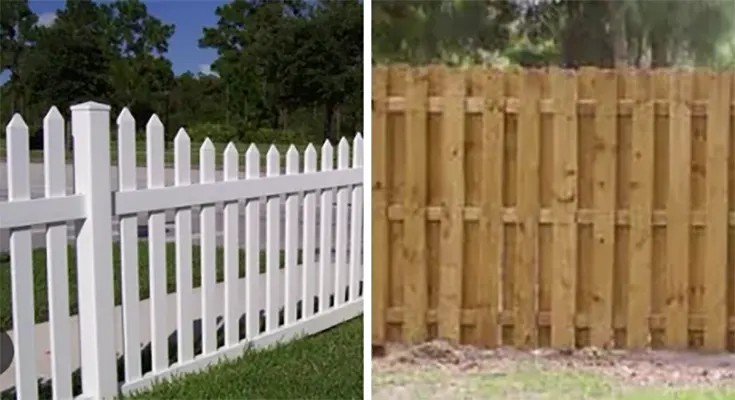Vinyl and wood are two of the most popular choices for fencing materials. Both vinyl and wood offer distinct benefits in terms of durability, aesthetics, and maintenance. However, cost is the biggest concern. Is vinyl cheaper than wood fencing? It depends on several factors, including the upfront cost, maintenance costs, and lifespan. We’ll compare the costs of vinyl fencing and wood fences to help you make a more informed decision.
Upfront Costs: Wood vs. Vinyl
Wood fencing is initially less expensive than vinyl. Wood prices vary depending on its type. Pine or spruce, which are common options, cost less while cedar and redwood, which are higher-end materials like redwood or cedar do not. A basic wood fence can cost anywhere between $10 and $20 per linear foot, while more expensive woods like cedar or redwood are priced higher.
Vinyl fencing is typically more expensive, starting at $20 to $40 a linear foot. The higher cost upfront can deter budget-conscious homeowners. It’s important to look at more than the initial cost.
Maintenance & Longevity
Wood may initially be less expensive, but its maintenance costs can accumulate over time. To protect wood fences from the elements, they require regular maintenance, such as painting, staining, and sealing. Wood is susceptible to insect damage, rot, and warping without proper maintenance. This can result in costly repairs or even a complete replacement. Even with regular maintenance, a wood fence can last 10 to 15 years.
Vinyl fencing is more expensive initially, but it requires little maintenance. It doesn’t require staining or painting and is resistant to pests, weathering, and rot. Only occasional washing with soap and warm water is required. Vinyl fences are also covered by warranties that last decades and have a lifespan of 20-30 years.
Long-Term Cost Comparison
Vinyl fencing is cheaper in the long run than wood. Wood fencing may initially be cheaper, but the maintenance costs and eventual replacements could offset those initial savings. Vinyl’s low maintenance and durability can save you money over the lifetime of the fence.
Aesthetic and Environmental Considerations
Cost is important, but aesthetics and the environmental impact are also factors. Some homeowners prefer wood’s natural appearance, as it blends in seamlessly with the landscape. Vinyl offers a uniform, clean appearance, and comes in a variety of styles and colors. Wood is renewable, but requires chemicals to preserve it. Vinyl is durable but made of PVC which has a higher carbon footprint. Some manufacturers offer recycled vinyl.
Conclusion
Vinyl fencing is more expensive than wood initially, but its longer lifespan and lower maintenance costs can make it an attractive option over time. Vinyl fencing is a good option if you want a fence with low maintenance and durability. Wood fencing is attractive, but it can be more expensive initially if you want to maintain the wood fence.
This post was written by a professional at WestCoast Fence Pros. WestCoast Fence Pros, based in Oxnard, CA, is your go-to expert for all your fencing needs. We specialize in commercial and residential projects, offering chain link fences, iron fences, vinyl fences, and wood fences. Our dedication to quality and customer satisfaction sets us apart from other chain link fence companies near you and wood fence companies near you. As one of the top iron fence contractors near you, we take pride in our craftsmanship and reliability. We also offer special discounts for seniors and veterans. If you’re looking for the best Ventura fence solutions, look no further than WestCoast Fence Pros.


